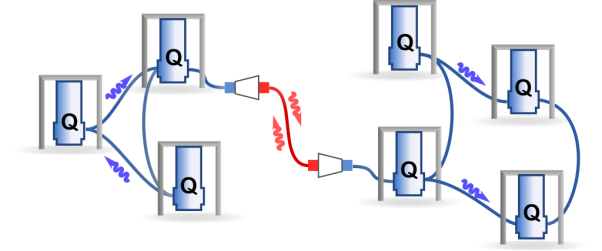FWF cluster of excellence: Quantum Science Austria
Quantum research has achieved amazing results in the understanding and control of ever more complex systems and thus it has opened a door to a new universe of questions and opportunities. The unique expertise available in Austria will be the basis for investigating outstanding fundamental questions in the three research areas of quantA:
– Quantum Nature of Space, Time, and Gravity (STG)
– New Paradigms for Quantum Information Science (QIS)
– Physics of Engineered Quantum Many-Body Systems (MBS)
These areas are strongly linked: for example, many-body correlations may significantly increase measurement capabilities such as the sensitivity to gravitational effects, while the quantum information approach to understanding many-body systems will lead to new insights into the emergence of physical theories at different scales while facilitating the practical development of complex quantum devices.
We are part of the following 2 collaborative core projects:
A Hybrid Polar Molecule – Superconducting Circuit Platform
Lead: Jörg Schmiedmayer (TUW) with Elena Redchenko (TUW)
Exploiting collective effects in circuit QED for bio inspired light harvesting, photon transfer and nonclassical light sources
Lead: Gerhard Kirchmair (UIBK) with Helmut Ritsch (UIBK)
Quantum Flagship: Open Superconducting Quantum  Computers
Computers
Just like its predecessor OpenSuperQ, the OpenSuperQPlus project is part of the European Quantum Technology Flagship. It is continuing and enhancing OpenSuperQ and brings together most of its team with new partners, resulting in a total of 28 partners from 10 countries under the leadership of Forschungszentrum Jülich.
At ISTA we will contribute to Enabling technology: “Noise-protected architectures and novel concepts” by designing, fabrication, characterization, calibration, and benchmarking of qubit circuits in novel parameter regimes. We will also contribute to developing new fabrication technologies that enable high-Q circuits.
ERC consolidator: Cavity Quantum Electro Optics – Microwave photonics with nonclassical states
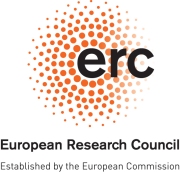
Optical photons propagate with ultra-low loss and do not interact easily which makes them perfect information carriers. Logical operations and sensing on the other hand rely on nonlinearities and strong interactions. GHz clock speed electrical circuits are used for computing and wireless receivers – a frequency range where also some of the most promising solid-state quantum devices, such as superconducting circuits and semiconductor spin qubits, operate and interact. The field of microwave photonics combines these two domains of the electromagnetic spectrum with a diverse set of applications ranging from radar and satellite communication, to radio-over-fiber and remote sensing. At the quantum level however, no equivalent technology exists. This is particularly problematic because quantum systems rely on analog information exchange in a low-noise environment. Microwave quantum circuits so far are restricted to operate inside an isolated space at millikelvin temperatures.
Building on our modular electro-optic platform – the lowest noise microwave-optical interconnect to date – cQEO will realize a remarkable set of new experiments that were not possible before: Heralded entanglement and teleportation of long-lived qubit states over kilometers of fiber, synthesis of optical cat states from microwave cats, photonic control and readout of superconducting circuits, as well as photonic masing and RF sensing below the standard quantum limit. Pushing towards higher electro-optic cooperativities will open up the rich physics known from cavity optomechanics, except now it is the readily accessible microwave field that experiences dynamical and quantum back-action rather than a mechanical mode. This is a new physical limit akin to nonlinear optics that was predicted a decade ago but never realized.
cQEO aims to uncover the full range of new physics offered by high quantum cooperativity electro-optics combined with the unique capabilities of circuit quantum electrodynamics.
NOMIS: Protected States of Quantum Matter
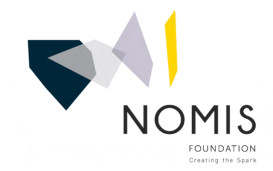
As many major corporations strive to build a quantum computer, there is a growing need to find better qubits. Led by Georgios Katsaros, Johannes Fink and Andrew Higginbotham at IST Austria, the project is working toward addressing some of the fundamental questions related to quantum information protection on the hardware level.
SFB: Quantum Information Systems Beyond Classical Capabilities
 A special research program (SFB) of the Austrian Science Fund (FWF): BeyondC
A special research program (SFB) of the Austrian Science Fund (FWF): BeyondC
After two decades of intensive experimental and theoretical research in quantum science, we have now reached a new era of quantum technologies. Several scenarios have been identified for which quantum information processing outperforms its classical analogue. We explore these new possibilities in a consortium with the expertise of seven experimental physics groups led by G. Kirchmair, T. Monz, G. Weihs (University of Innsbruck), Ch. Roos (IQOQI Innsbruck), J. Fink (IST Austria), Ph. Walther (University of Vienna) and six theory groups led by J. I. Cirac (MPQ, Garching, Germany), H. Briegel, B. Kraus, W. Lechner (University of Innsbruck), C. Brukner, F. Verstraete (University of Vienna).
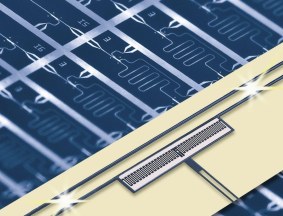
P05 – Integrating Superconducting Quantum Circuits: Superconducting processors offer fast clock speeds and a promising potential for scalability, but even with state of the art gate fidelities an excessive overhead of physical qubits is required to encode each single logical qubit. Our long-term goal is to lay the scientific foundation of a highly integrated chip-based quantum computer hardware that is ready for both, fast local processing and long-distance quantum communication. The first 4 years will be dedicated to improving single and few qubit properties and to study the interaction and dynamics of medium-scale integrated quantum circuits. In the first part we will investigate new directions to reduce the circuit size without compromising coherence by employing new types of substrates, fabrication technology and circuit designs. In the second part we will investigate the potential of collective multi-qubit states for analog quantum simulation, sensing and quantum annealing. Towards the end of the reporting period we plan to use the developed qubit hardware as a non-classical resource in long-distance fiber optic quantum networks.
Fellowships
NOMIS fellow, Andrei Militaru: Levi-CirQED: Coupling levitated nanoparticles and circuit QED through cavity quantum electro-optics
Affiliated Projects / Networks
QuantA: CoE application consortium uniting quantum scientists of Austria.
CoQuS: The Vienna Doctoral Program on Complex Quantum Systems is a training center for more than 40 students who are selected from an international pool of applicants, based on their academic excellence, scientific success and ambition. CoQuS is funded by the Austrian Science Fund (FWF).
ML4Q: Matter and Light for Quantum Computing is a Cluster of Excellence funded within the Excellence Strategy by the German Research Foundation (DFG).
OpenSuperQ: An Open Superconducting Quantum Computer is a quantum flagship project funded by the European Union.
VCQ: Vienna Center for Quantum Science and Technology uniting quantum physicists of Vienna’s research institutions in one collaborative center.
Previous Projects & Fellowships
FETopen: Superconducting quantum local area networks
Superconducting quantum circuits are one of the most promising platforms for realizing large-scale quantum computing devices, where in the near future a coherent integration of 100-1000 quantum bits (qubits) is feasible. However, the required temperatures of only a few mK currently restrict quantum operations to qubits that are located within a single, heavily shielded dilution refrigerator. This imposes a serious constraint on the realization of even larger quantum processors or the implementation of local- and wide-area quantum networks based on this technology.
The project SuperQuLAN is set out to address this important open problem and to demonstrate a first operational prototype quantum local area network of separated superconducting quantum processors. This work will be carried out together with TU Vienna, ETH Zurich, CSIC, MPL and Zurich Instruments, who all will develop key network components and quantum communication protocols that will facilitate in the long term the realization of large quantum computing clusters or even city-wide quantum networks using superconducting circuits.
The project is funded by the Horizon 2020 research and innovation programme of the European Union.

FETopen QUARTET: Quantum readout techniques and technologies
The general aim of this project is to exploit quantum information to develop new powerful methods for the retrieval and recognition of classical data from physical systems. More precisely, we aim at showing a substantial quantum-enhancement in several fundamental tasks: (1) the readout of classical data from digital memories (quantum reading); (2) the recognition of classical patterns (quantum pattern recognition); (3) the optical measurement of concentration in fragile biomedical samples (quantum bio-probing); and (4) the microwave detection of target objects (microwave quantum illumination or quantum radar). These objectives are realized starting from the optimization of a general theoretical model at their basis: quantum channel discrimination. This is then developed into technical aspects which directly support our experimental proofofprinciple demonstrations.
Coordinator: S. Pirandola (York)
ERC starting QUNNECT: A Fiber Optic Transceiver For Superconducting Qubits

Research in optical quantum networks and superconducting devices has progressed largely independently so far. While superconducting qubits are ideally suited for on-chip integration and fast processing, they are problematic for quantum communication. No solution exists to connect remote qubits via a room temperature link. The small energy scales in the electrical circuit make the fragile information carriers (single microwave photons) susceptible to interference, thermal noise and losses, which has hindered any significant progress in this direction.
We recently have gained sufficient insight into low loss materials, the required fabrication technology, and the precision measurement techniques necessary to bridge the two worlds, by controlling individual photons and phonons quantum coherently. We are working towards integrating silicon photonics for low-loss fiber optic communication with superconducting circuits for quantum processing on a single microchip. As intermediary transducer we will focus on two approaches:
(1) quantum ground state cooled nanoscale mechanical and
(2) low-loss electro-optic nonlinear circuit elements.
The novelty of our approach in QUNNECT is the tight on-chip integration facilitated by our groups interdisciplinary background in both, superconducting circuits and silicon nanophotonics. Integration will be the key for realizing a low-loss and high-bandwidth transceiver, for preparing remote entanglement of superconducting qubits, and for extending the range of current fiber optic quantum networks.
ISTfellow, Liu Qiu: Quantum Optical Control and Readout of Superconducting Microwave Circuits with Hybrid Transducers
ÖAW DOC, Elena Redchenko: Controllable States of Superconducting Qubit Ensembles
Nomis: Hybrid Semiconductor – Superconductor Quantum Devices

Using quantum states of microscopic physical systems for more effective problem solving is not a new idea, but only just now, after many decades of basic research, nanofabrication and quantum control technology have evolved sufficiently to make an attempt to build a microchip-based quantum computer. While it is clear that drastic algorithmic improvements are still needed for useful quantum processing, there is also no consensus about the ideal hardware to use. Very important basic questions are still unanswered. Can we find designs with built-in hardware-protection to extend the coherence times of superconducting qubits further? How can we reliably generate, detect and make use of exotic quasiparticles such as Majorana fermions?
In this project funded by a NOMIS research grant we join forces with the Katsaros group to give answers to these important questions. The goal is to improve the properties of superconducting and semiconducting qubits and to couple them with superconducting bus systems. Such hybrid devices might prove to be the most promising building blocks for future quantum devices.
FET proactive: Hybrid Optomechanical Technologies
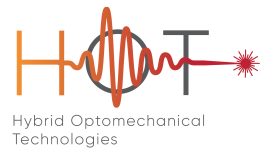
The HOT consortium funded by the European Union Future and Emerging Technology proactive scheme aims to lay the foundation for a new generation of devices, which connect or even contain, several platforms at the nanoscale in a single “hybrid” system. As hybrid interfaces they will allow the exploitation of the unique advantages of each subsystem within a nano-scale footprint, while as integrated hybrid devices they will enable entirely novel functionalities.
A particular focus is to explore hybrid opto- and electro-mechanical devices operating at the physical limits for conversion, synthesis, processing, sensing and measurement of electromagnetic (EM) fields, from radio and microwave frequencies to the terahertz domain. These spectral regions are relevant to the important existing application domains of medicine (e.g. MRI imaging), security (e.g. Radar and THz monitoring), positioning, timing and navigation (oscillators) and for future quantum technology.
ISTplus, Yuan Chen: A GHz frequency electro-optomechanical
slot mode optomechanical crystal design for transduction and sensing
ÖAW DOC, Georg Arnold: Coherent on-chip conversion of superconducting qubit signals from microwaves to optical frequencies
ISTplus, William Hease: High efficiency microwave to optical photon conversion in lithium niobate rings
SUPEREOM: Quantum teleportation and Quantum Illumination with Cavity Optomechanics, a Marie SkŁodowska-Curie individual fellowship obtained by Shabir Barzanjeh (2016-2018)

